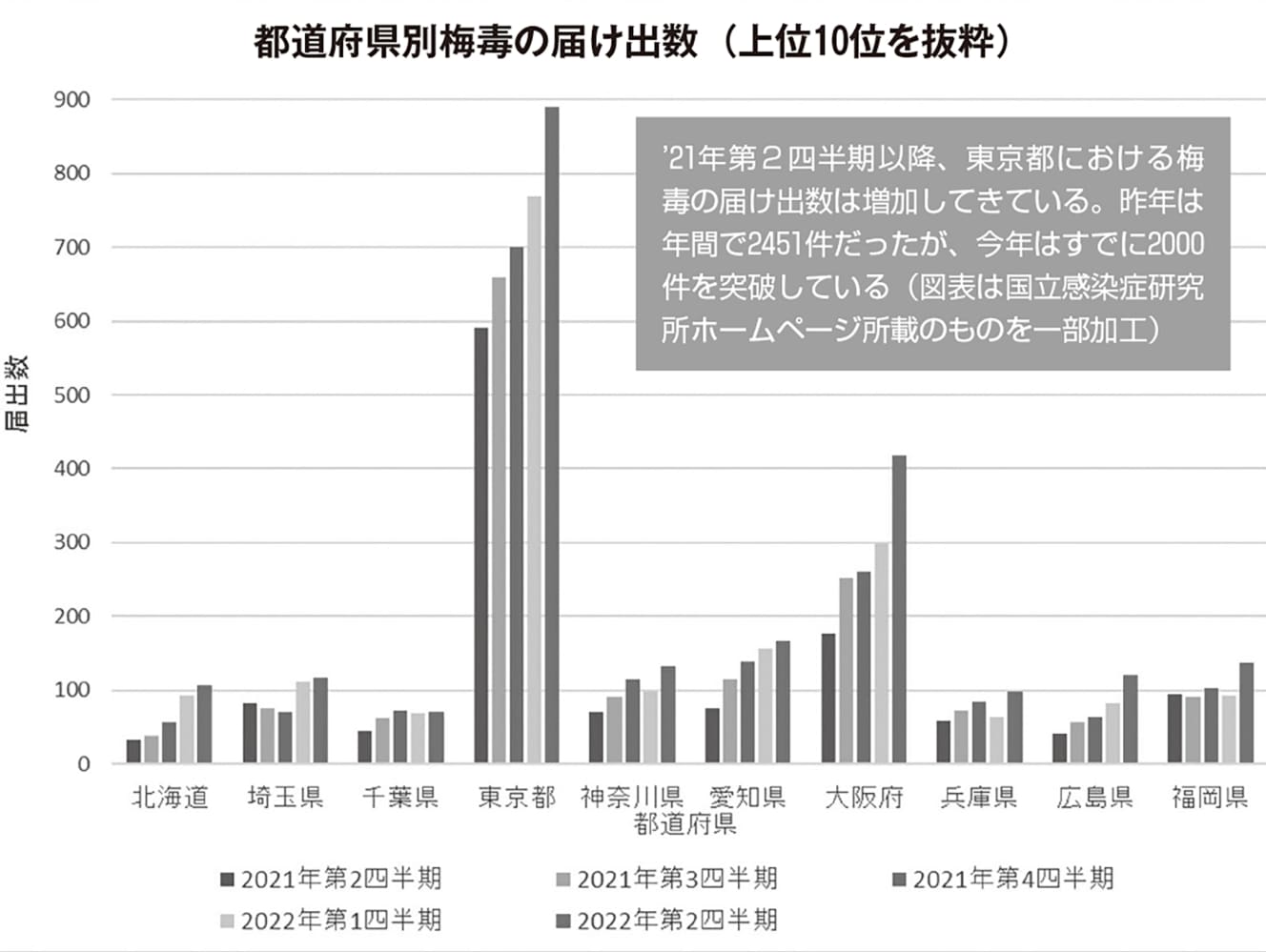Factors behind the surge in syphilis…? Fear of “STD PRINCESS PRINCESS” who walk around from store to store
The reality of Piena, as depicted by a writer who is currently a student at Keio University. 4 years after Reiwa, Kabukicho is now ...... No. 26
The number of people infected with syphilis is rapidly increasing in Japan. According to the National Institute of Infectious Diseases, the number of infected persons exceeded 6,000 nationwide as of July, 1.7 times the number during the same period last year. If the number continues to increase at this pace, it is likely to exceed 10,000 for the first time since ’99, when the current statistics began being compiled.
Looking at the survey results by age group, while men are infected overall from their 20s to 50s, the numbers of women aged 20 to 24 are outstanding.
The highest number of infected people in Japan is, of course, in Tokyo, and Kabukicho residents fear that they could contract the disease at any moment.
To be honest, STD testing is not mandatory at some establishments,” said one Kabukicho resident.
Madoka (pseudonym, 22) works at a delicatessen in Kabukicho.
Some high-class soaps require monthly STD testing even if you are wearing a condom, but inexpensive soaps and delicatessen establishments may require you to report whether you have an STD or not, or they may just say something as light as, ‘You’ll get it. There are even prostitutes who tweet on Twitter, “Even if I get an STD, I’ll go to work because I want to pass it on to my clients.” …… I have never heard of a place that tests customers for STDs, and the sex industry is really lax about STDs.
Recently, an account symbolizing such laxity appeared on SNS. A girl who works at a soapland in Kawasaki posted on her Instagram story, “I think I have syphilis,” and “I have gonorrhea, chlamydia, and condyloma confirmed now. She referred to herself as the “STD PRINCESS PRINCESS.
Another girl at a soap establishment where “PRINCESS PRINCESS” is employed checked with the establishment and discovered that she had continued to work there even after posting the post. Her presence shook not only those involved in the sex industry but also the men who were her customers.
Since then, “STD PRINCESS PRINCESS” has changed her enrollment one after another. Each time, she was identified and spread on SNS, and finally a person who seemed to be a scout who introduced her to the store despite knowing that she had an STD was also identified. In the end, a scout who knew she had an STD and introduced her to the store was identified. It is not surprising that the same people would be concerned about a girl with a sexually transmitted disease working in a store.
A number of women feared that they might be exposed to customers who had nominated “PRINCESS PRINCESS” themselves.
Masato (pseudonym), a scout, said.
When a girl gets an STD and is suspended from high-class soap operas, she immediately moves to another delicatessen. There are also girls who go to cabarets to do pillow talk, and paparazzi activities are naturally high-risk because they are between individuals. I hear that syphilis is prevalent not only in Kabukicho, Kawasaki, and Yoshiwara, but also in Minato Ward. Many men blame the girls, but sometimes the customers are spreading STDs. I think the only way is to require sex workers and customers to submit STD test charts for the last month or something. But if we do that, sales will surely drop, so the stores will not want to do it. If things continue as they are now, the number of STDs will only increase.
Some people who work at night are financially strapped and continue to work for a living even though they have symptoms that seem to be related to STDs. In order to reduce the number of STDs, including syphilis, it will be necessary to make regular STD testing a routine in addition to hand washing, gargling, and masking, which has become a habit due to the COVID-19 crisis.
Sasaki Chihuahua
Born in Tokyo in 2000.
After attending an integrated school in Tokyo from elementary school to high school, he went on to Keio University.
He has been going to Kabukicho since he was 15 years old and has a wide range of personal connections. At the university, he is studying sociology of the downtown area including Kabukicho.
His book, ” Pien” to shakai” (“The Disease of ‘Pien’: Consumption and Approval of the SNS Generation”), is now on sale.
Interview and text: Sasaki Chihuahua
